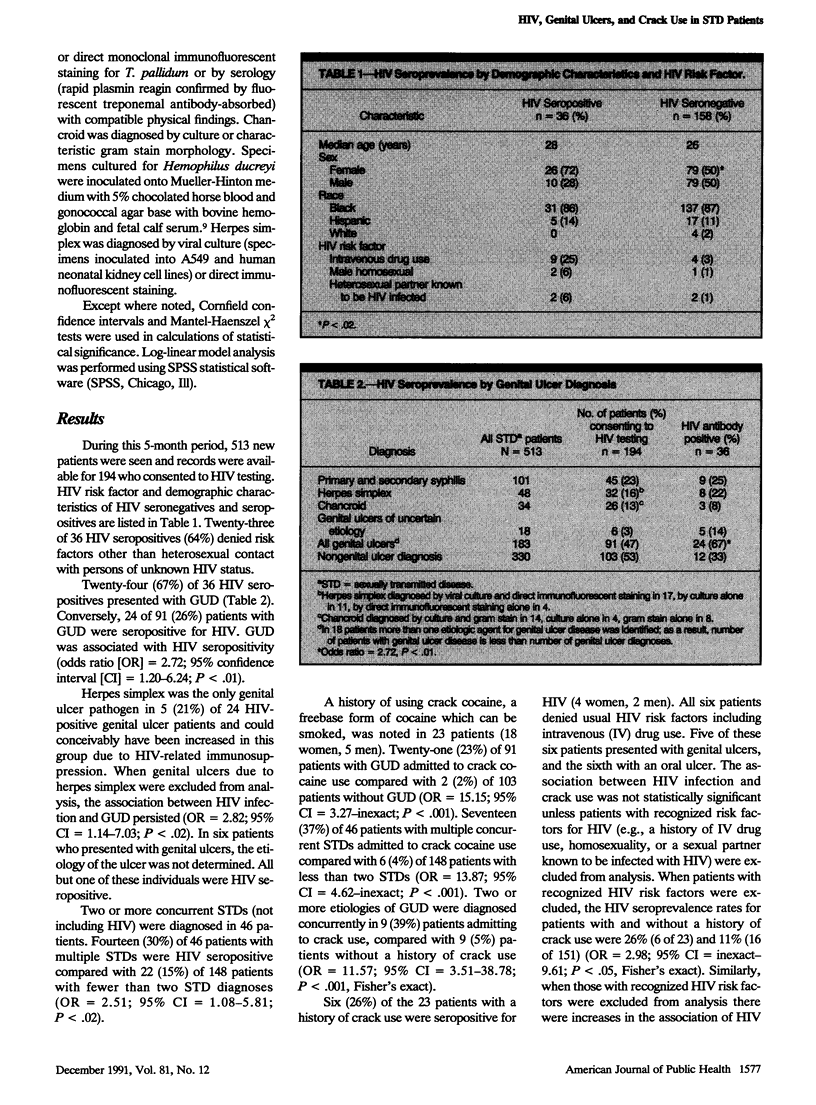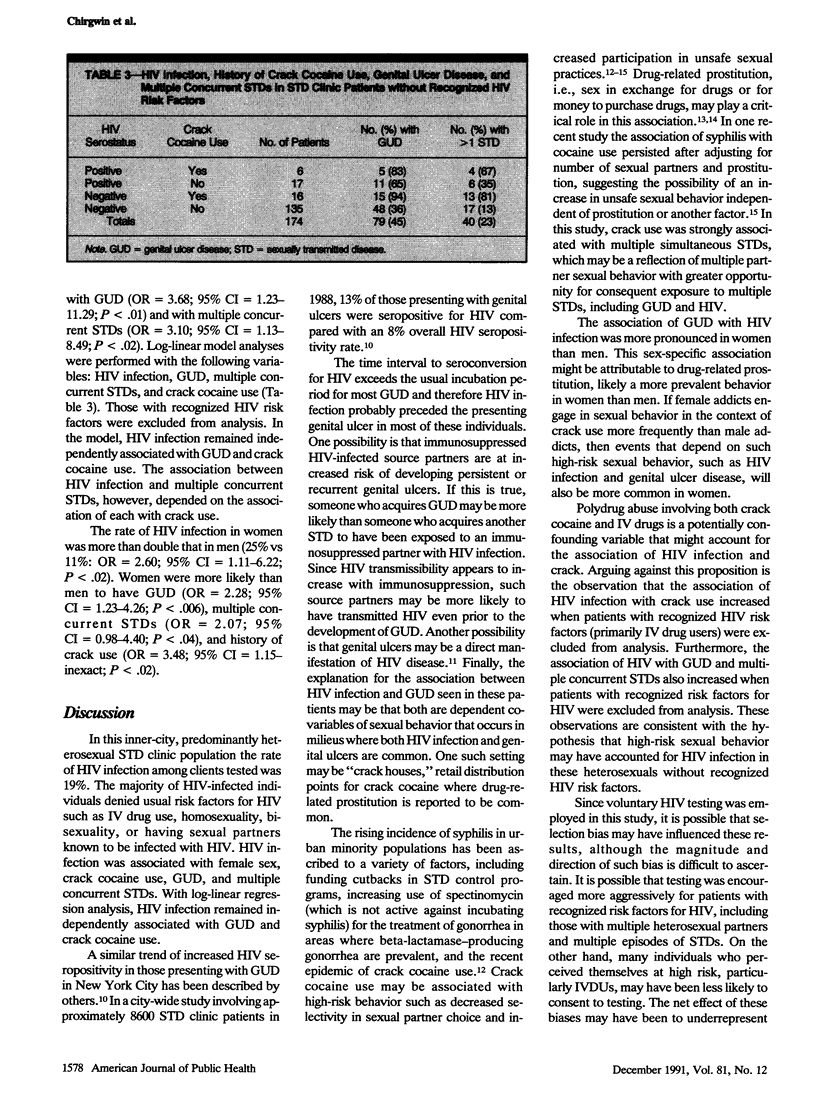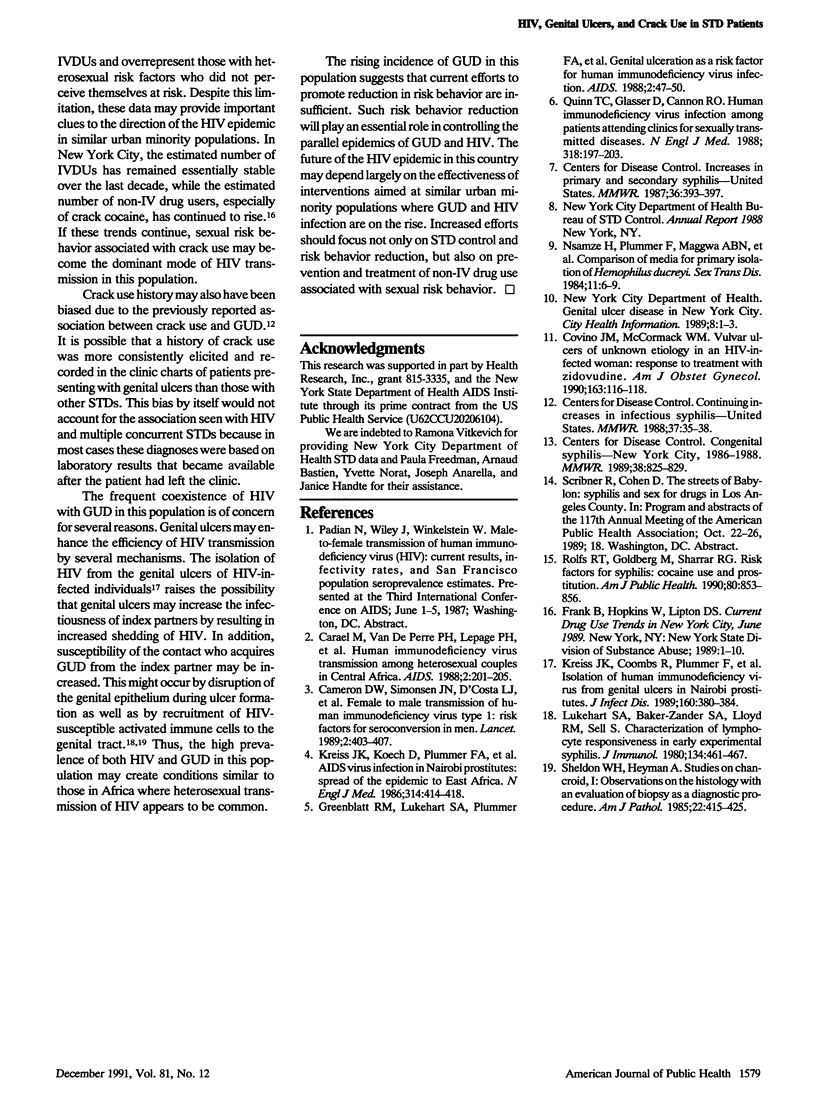Abstract
BACKGROUND. Recently there has been a rise in genital ulcer disease (GUD) in urban minority heterosexuals in the United States. The impact of these increased GUD rates on HIV transmission patterns in this population is unknown. METHODS. Sexually transmitted disease (STD) diagnoses were correlated with HIV antibody status and risk factor history in 194 patients who consented to HIV testing at an STD clinic in central Brooklyn. RESULTS. Of 36 HIV-positive patients, 23 (64%) denied HIV risk factors other than heterosexual contact with persons of unknown HIV status. HIV antibody was associated with GUD (odds radio [OR] = 2.72, 95% confidence interval [CI] = 1.20-6.24), multiple concurrent STDs (OR = 2.51, 95% CI = 1.08-5.81), and a history of crack cocaine use (OR = 2.98, 95% CI = inexact-9.61). Crack use was also associated with GUD (OR = 15.15, 95% CI = 3.27-inexact) and multiple simultaneous STDs (OR = 13.87, 95% CI = 4.62-inexact). In a log-linear model analysis, HIV infection was independently associated with GUD and crack use. HIV infection, genital ulcer disease, and crack cocaine use were more common in women than men. CONCLUSIONS. The association between HIV infection and GUD seen here may be secondary to high-risk sexual behavior, which in turn may be partially attributable to crack cocaine use and drug-related prostitution. The high rate of coinfection with HIV and GUD raises a concern about the increased efficiency of sexual transmission of HIV in this population.
Full text
PDF



Selected References
These references are in PubMed. This may not be the complete list of references from this article.
- Cameron D. W., Simonsen J. N., D'Costa L. J., Ronald A. R., Maitha G. M., Gakinya M. N., Cheang M., Ndinya-Achola J. O., Piot P., Brunham R. C. Female to male transmission of human immunodeficiency virus type 1: risk factors for seroconversion in men. Lancet. 1989 Aug 19;2(8660):403–407. doi: 10.1016/s0140-6736(89)90589-8. [DOI] [PubMed] [Google Scholar]
- Carael M., Van de Perre P. H., Lepage P. H., Allen S., Nsengumuremyi F., Van Goethem C., Ntahorutaba M., Nzaramba D., Clumeck N. Human immunodeficiency virus transmission among heterosexual couples in Central Africa. AIDS. 1988 Jun;2(3):201–205. [PubMed] [Google Scholar]
- Covino J. M., McCormack W. M. Vulvar ulcer of unknown etiology in a human immunodeficiency virus-infected woman: response to treatment with zidovudine. Am J Obstet Gynecol. 1990 Jul;163(1 Pt 1):116–118. doi: 10.1016/s0002-9378(11)90682-6. [DOI] [PubMed] [Google Scholar]
- Greenblatt R. M., Lukehart S. A., Plummer F. A., Quinn T. C., Critchlow C. W., Ashley R. L., D'Costa L. J., Ndinya-Achola J. O., Corey L., Ronald A. R. Genital ulceration as a risk factor for human immunodeficiency virus infection. AIDS. 1988 Feb;2(1):47–50. doi: 10.1097/00002030-198802000-00008. [DOI] [PubMed] [Google Scholar]
- Kreiss J. K., Coombs R., Plummer F., Holmes K. K., Nikora B., Cameron W., Ngugi E., Ndinya Achola J. O., Corey L. Isolation of human immunodeficiency virus from genital ulcers in Nairobi prostitutes. J Infect Dis. 1989 Sep;160(3):380–384. doi: 10.1093/infdis/160.3.380. [DOI] [PubMed] [Google Scholar]
- Kreiss J. K., Koech D., Plummer F. A., Holmes K. K., Lightfoote M., Piot P., Ronald A. R., Ndinya-Achola J. O., D'Costa L. J., Roberts P. AIDS virus infection in Nairobi prostitutes. Spread of the epidemic to East Africa. N Engl J Med. 1986 Feb 13;314(7):414–418. doi: 10.1056/NEJM198602133140704. [DOI] [PubMed] [Google Scholar]
- Lukehart S. A., Baker-Zander S. A., Lloyd R. M., Sell S. Characterization of lymphocyte responsiveness in early experimental syphilis. II. Nature of cellular infiltration and Treponema pallidum distribution in testicular lesions. J Immunol. 1980 Jan;124(1):461–467. [PubMed] [Google Scholar]
- Quinn T. C., Glasser D., Cannon R. O., Matuszak D. L., Dunning R. W., Kline R. L., Campbell C. H., Israel E., Fauci A. S., Hook E. W., 3rd Human immunodeficiency virus infection among patients attending clinics for sexually transmitted diseases. N Engl J Med. 1988 Jan 28;318(4):197–203. doi: 10.1056/NEJM198801283180401. [DOI] [PubMed] [Google Scholar]
- Rolfs R. T., Goldberg M., Sharrar R. G. Risk factors for syphilis: cocaine use and prostitution. Am J Public Health. 1990 Jul;80(7):853–857. doi: 10.2105/ajph.80.7.853. [DOI] [PMC free article] [PubMed] [Google Scholar]
- Sheldon W. H., Heyman A. Studies on Chancroid: I. Observations on the Histology with an Evaluation of Biopsy as a Diagnostic Procedure. Am J Pathol. 1946 Mar;22(2):415–425. [PMC free article] [PubMed] [Google Scholar]


